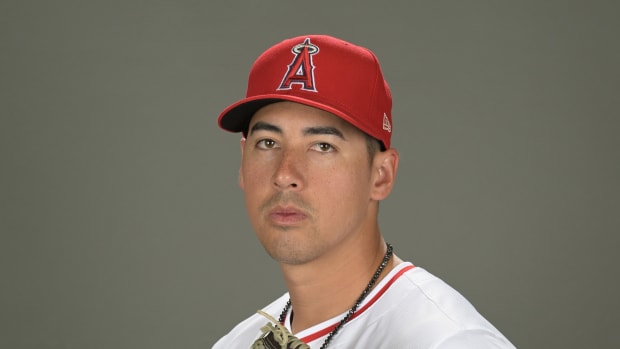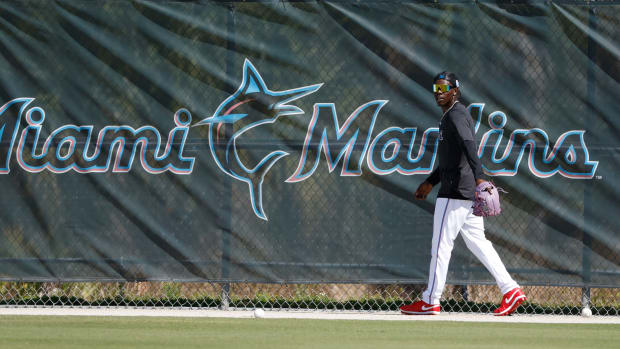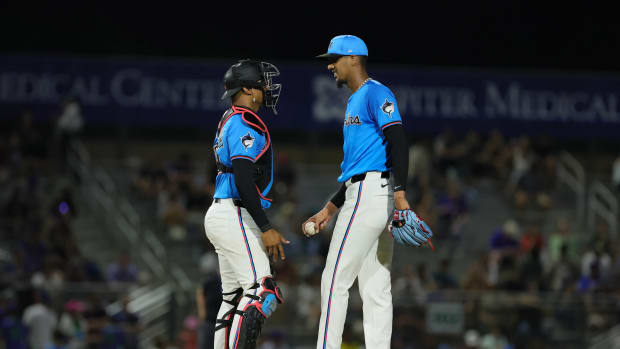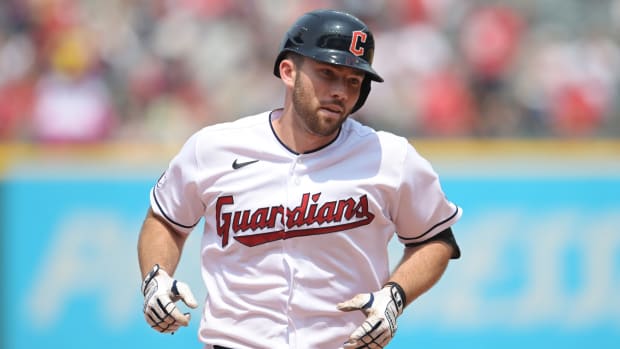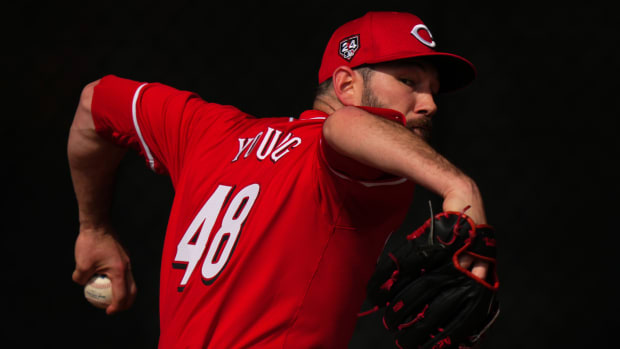How Justin Verlander Mastered Body and Mind to Dominate in His Mid-30s
The wise men of baseball like to say there are only two kinds of baseball players: those who have been humbled and those who are about to be. The baseball gods are very protective, even cruelly so, about who gets to master their game. To be imbued with elite physical skills is the common gift of youth. But just as you accumulate the wisdom from repetitions, age dulls the physical edge.
Body and mind. Rarely do the twain intersect at their peaks. When they do, the intersection creates generational greatness. Justin Verlander has found the sweetness of that intersection, and not just for one day, Sunday, when he threw the third no-hitter of his career. He has found it three seasons running in Houston.
“See that man right there?” Astros pitching coach Brent Strom said one day in spring training as Verlander walked by. “He’s amazing. You know what his goal is, don’t you? His goal is to pitch until he’s 45, like his idols, Roger Clemens and Nolan Ryan.”
Verlander took the ball Sunday in Toronto at 36 years, 193 days old. Age is the mortal enemy of power pitching.
Nobody that old had thrown a shutout in the major leagues in four years, since Bartolo Colon in 2015. Nobody that old had struck out 14 batters in a game in 15 years (Curt Schilling, 2004). Nobody that old had thrown a no-hitter in 15 years (Randy Johnson, 2004). Nobody that old had thrown a no-hitter with 14 strikeouts in 28 years (Ryan, 1991).
And nobody that old had thrown a no-hitter with 14 strikeouts and only one baserunner in … forever.
Verlander did it. And when he did, getting Bo Bichette on a ground ball with his 120th pitch, Verlander reacted with more emotion than he did for his first no-hitter, when he was 24, or his second no-hitter, when he was 28. He knows well the body/mind tradeoff. He also knows history, admitting after the game he knows the exclusivity of throwing three no-hitters is well beyond that of throwing two of them.
Two hundred sixty-three pitchers have thrown one no-hitter, including Bud Smith. It’s called the game of a lifetime.
Twenty-nine pitchers have thrown two no-hitters, including Mike Fiers. It’s called lightning striking twice.
Only six pitchers have thrown three or more no-hitters: Larry Corcoran, Cy Young, Bob Feller and only three men since Jackie Robinson opened the game for all in 1947: Sandy Koufax, Ryan and Verlander. That’s called legendary.
Koufax, a teammate of Robinson’s, threw his last major league pitch Oct. 6, 1966.
Ryan threw his first pitch 25 days earlier, on Sept. 11, 1966, and his last on Sept. 22, 1993, lasting long enough for a 10-year-old Verlander to see him near the end.
Koufax to Ryan to Verlander. This is how royal crowns are passed. These are the pitchers who resonate so strongly in our memories that with the passing of enough years merely having seen them becomes a point of pride, as in “I saw Koufax.” The same will be said one day about Verlander.
None of this legendary twain of body and mind seemed possible on the night of Aug. 11, 2014, not as Verlander sat crying in a tunnel between the dugout and the Tigers’ clubhouse at PNC Park in Pittsburgh. The Pirates had knocked him out with five runs in just one inning. Verlander averaged just 92.7 mph with his fastball—flat mediocre. His ERA was 4.76. He hadn’t been the same after offseason core muscle surgery. And now his shoulder ached badly. He cried because he was certain he would need shoulder surgery, and that would be the end of his career.
He would become just another usual casualty of the baseball gods, what with his body breaking down at 31 and his best days behind him.
But Verlander did not need surgery, and attacked his training regimen with renewed purpose and vigor. He missed 12 starts the next year, 2015, with a lat tear, but threw the ball much better. But his career catapulted to another level when he joined Houston after the trade from Detroit on Aug. 31, 2017.
If you ranked the major league teams then according to technology and resources, the Tigers would have ranked in the bottom three and the Astros would have been in the top three. It was the equivalent of moving from Green Bank, West Virginia, where there are no wireless devices (because of an enormous telescope) to Silicon Valley.
A new world opened for Verlander. He ditched his two-seam fastball because the Astros showed him pitch metrics that revealed it was nothing but a weaker version of his four-seamer (same run, less jump). He fixed his slider when the Astros showed him high-speed camera images of how the baseball was coming off his fingers (it “popped up” slightly, allowing hitters to distinguish it early from his fastball).
“So it was pretty simple for me,” Verlander told me in spring training about the fix to his slider. “Stay behind it, and it’s going to look like a four-seamer out of my hand. It may not have the [same] break, and it may not have the [velocity] separation, but it’s a better pitch.”
They introduced him to fastball spin rate, which is a way of measuring the “hop” on a fastball, and showed him why some of his fastballs were better than others.
"I didn’t know the numbers, the spin rate,” Verlander said. “They identified the pitches with the spin rate that had the jumps and showed me the clips when the [lower] spin rate was about the 23 [hundred] or something. They showed me the upper echelons of my spin rate before and I brought the average up to where that was.”
By repeating the mechanics of his best fastball—nothing is more important than keeping the hand behind the baseball to throw true north-south spin without wobble—Verlander was able to repeat those elite fastballs rather than throwing them once in a while.
There was one more fix in order. Because of health issues, Verlander had unintentionally modified his delivery to throw with a lower release point. As he returned to better health and worked with Houston’s data, Verlander has restored his higher release point. His average vertical release point went from 6.36 feet with Detroit in 2017 to 6.78 feet last year to 6.93 feet this year. And with that higher release point he has restored his changeup, a pitch he essentially quit throwing for three years because hitters devoured it.
When he took the mound Sunday, Verlander was throwing with the highest average release point in baseball and the second highest fastball spin rate among all starting pitchers (2,576 rpm). Verlander bullied the Blue Jays with 75 fastballs—his most in almost 13 months. It wasn’t because he was throwing harder. It was because he was reading how hitters reacted to it.
And that is what happens beyond the data. Verlander may have improved his game with the technology, but on the mound he becomes a prize fighter in the ring. Qualities such as competitiveness, savviness and instincts must take over where the data leave off.
When I asked him about technology, he replied, “I utilize it a lot. Everything from Trackman data to slow-motion footage. A lot of different things. It’s a tool you’d be ignorant to not use. But I also believe you’d be ignorant to buy all into it.”
I asked him what he meant by that. He gave me an example from last year.
“My slider for a month and a half last season in my eyes was not having results,” he said. “Hitters were seeing it. They were taking the good ones and pounding the bad ones. The Trackman data kept saying, ‘Hey, this is good, it’s probably even better than it was earlier in the year.’
“Eventually I’m like, ‘Screw it. I’ve got a pretty good Trackman in my head that you guys don’t have, and that’s to see the reaction of the hitter. It’s not better.’ And I went to a shorter version that probably didn’t grade out as well and didn’t look as sexy on the Trackman but all of a sudden I started to see the swings and reactions I wanted.
“You can’t put all your eggs in one basket. And I think that’s a thing the Astros do pretty well. At least on our level. A good rapport with the player and the analytical guys. I think we have good conversations. And honestly, they get pretty heated at times. They do. I think we challenge each other and ultimately we wind up in a better place. There are times when they say, ‘You’re right, we should look at that,’ and times when I’ll say, ‘I probably should have done that.’ It happens a lot.”
His start Sunday, with the stuff he brought to the mound and the way he read the Toronto hitters in deciding how to use it, was the perfect intersection of combining a physical peak with years of wisdom.
In the past three seasons, from ages 34 to 36, which includes the 28 starts he made for the Tigers in 2017, Verlander has 48 wins, 766 strikeouts and a 2.86 ERA. Only one other pitcher has reached those thresholds at that age since 1893, when the mound distance of 60 feet, six inches was put in place: Randy Johnson.
We are watching one of the rare masters. The no-hitter Sunday wasn’t some anomaly, the way it was for 37-year-old Bob Keegan in 1957, or some last gasp of greatness, the way it was for David Cone, who was Verlander’s age when he threw his perfect game in 1999. This day and this pitcher look more like another Ryan, who threw his sixth no-hitter at 43 and his seventh at 44. At 36 years old, as one of the rare concessions from the baseball gods, Verlander is in his prime.



































